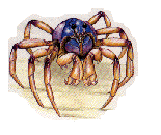The animal kingdom is so crowded with thousands of wonderful species, so biologists have divided the animals into 6 broad groups to make it easier to understand. The groups are:
Invertebrates
Reptiles
Fish
Birds
Amphibians
Mammals

| The Animal Kingdom
The animal kingdom is so crowded with thousands of wonderful species, so biologists have divided the animals into 6 broad groups to make it easier to understand. The groups are: Invertebrates |
 |
|
Invertebrates:
These
are animals without backbones. They include insects, spiders, corals, octopuses,
crabs, jellyfish, starfish, worms, millipedes and snails. Invertebrates
live in every habitat and come in countless shapes and sizes, from microscopic
single celled animals to giant squid more than 20 metres long. They were
the first animals on Earth and evolved in the oceans about 800 million
years ago. More than 225,000 land invertebrates have been discovered in
Australia, but scientists believe there are at least one million invertebrate
species in Australia.
|
 |
|
Reptiles:
These
are animals that:
Snakes,
lizards, crocodiles and turtles are all reptiles, and the dinosaurs were
reptiles. They usually lay eggs, although a few snakes and lizards give
birth to live young. Only sea snakes, crocodiles, turtles and tortoises
live in the water. Reptiles evolved from the amphibians,
and first appeared on Earth about 300 million years ago. There are around
6000 species in the world today, and Australia has 725 different species.
|
 |
|
Fish:
These
are animals that:
Fish
live in the oceans and in freshwater rivers and lakes, and have an amazing
variety of forms, from streamlined sharks to stiff, bony seahorses. They
are adapted to live in water, but some, like freshwater eels, are able
to move on land between waterholes. Some fish can survive droughts by burrowing
deep into the mud and breathing air. Fish were the first animals to have
backbones (vertebrates), and evolved from the invertebrates
(animals without backbones) 500 million years ago. There are about 21,000
species of fish in the world. Australia has about 200 different freshwater
fish and more than 2000 species of saltwater fish in the oceans.
|
 |
|
Birds:
These
are animals that:
Birds
have very light hollow bones and wings instead of front legs. Most can
fly, although penguins have flippers instead of wings, and are able to
swim very fast. A few ground-living birds like the emu and cassowary are
good runners. They have small wings and are unable to fly. Birds shed (moult)
most of their feathers every year and grow new ones to replace them. The
first birds evolved from small running reptiles
(dinosaurs) about 140 million years ago. There are now more than 9000 different
birds alive in the world today, and about 750 species of bird in Australia.
|
 |
|
Amphibians:
These
are animals that:
Amphibians
live partly in the water and partly on the land, and evolved from the fish
about 380 million years ago. There more than 3000 species alive in the
world today. They include frogs, toads, salamanders and newts. Frogs are
the only native amphibians in Australia, and there are 180 different species.
Most frog lay eggs in freshwater ponds. They hatch into tadpoles which
look like small fish with fins and gills. When they are fully grown, tadpoles
turn into frogs and move onto the land. Frogs breathe with lungs and have
moist skin, so they usually stay in damp places. Some live in the desert,
and when the waterholes dry out they hide in moist burrows until it rains.
|
 |
|
Mammals:
These
are animals that:
Most
mammals live on the land, although some, like dolphins and dugongs, live
in the sea. Some mammals burrow beneath the ground, some live in trees,
and others, like bats, are able to fly. They platypus and echidna are the
only mammals to lay eggs. They are called monotremes. Many Australian mammals,
like kangaroos and possums, give birth to tiny, undeveloped young, which
usually live in a pouch on the motherís belly. They are called marsupials.
The other mammals give birth to fully formed young, and are known as eutherians.
Mammals evolved from reptiles about 200 million
years ago. There are 248 different mammals in Australia and around 4000
species in the whole world.
|
 |
© Created By AJM
NETWorks ©
1 September 2000